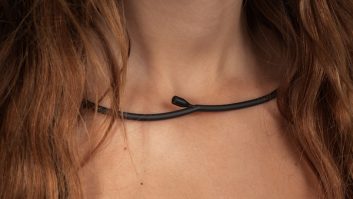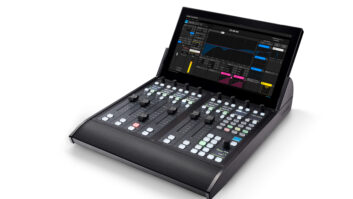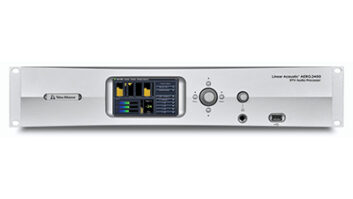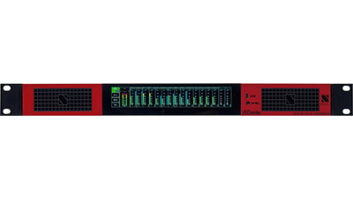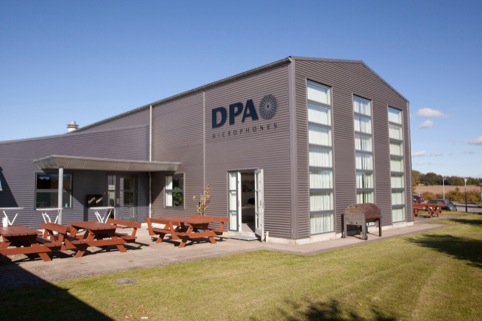
DPA (Danish Professional Audio) Microphones is striving to be the premiere condenser microphone manufacturer in the world. Neal Romanek visited their headquarters outside Copenhagen and their factory in the Danish countryside to learn why, for DPA, good isn’t good enough.
Conversations about higher image resolution are so ubiquitous they have become background static. But outside pro audio circles, higher quality recording gets scant attention. Maybe it’s human nature that we value what we can see over what we can’t, but anyone who has seen great footage ruined by inferior audio knows that good sound recording is as important as good image capture.
DPA Microphones’ CEO, Christian Poulsen (pictured, below), is not interested in good sound capture, or even great sound capture. For Poulsen, the quest for perfect sound capture is a mission that drives the entire company.
Poulsen became CEO of DPA in 2010 after leaving Hasselblad, where he spearheaded the high-end camera company’s transition to digital imaging. Prior to that he pioneered the development of high-end digital scanners at his company Imacon. Throughout his career, employing precision engineering to create the highest quality creative tools has been Poulsen’s passion.
Education
DPA’s microphones have been a leading mic choice for live performers, West End shows and music recording. In these performance venues, the need for high-end mics is self-evident, but selling the picture-obsessed broadcast industry on better recording technology requires sustained effort.
Says CEO Poulsen, “I think we have a big job in education. We are a price leader in all our products, so in that respect it is easy to be perceived as over-expensive. A producer might ask a recording engineer: ‘Why can’t you get away with a Countryman or a Senken microphone?’ He could and it will sound ok. But will he spend more time? Yes. Will he have to reshoot more? Probably.”
DPA sees education as so important to its mission that it has published a ‘Mic University’ on its website, featuring dozens of articles and technical papers on the practice and technology of sound recording. Poulsen believes that you can’t sell quality microphones unless you have quality engineers, and there is little about the technique of sound reproduction the ‘University’ doesn’t cover.
Getting The Voice right
Though the R&D and testing facilities at the DPA factory are impressive, DPA’s regards real-world trials as an essential part of the design process. The development of their new vocal condenser microphone, the d:facto, took place in collaboration with The Voice of Denmark, Voice – Danmarks største stemme – on TV2. DPA R&D Manager, Ole Moesmann, went to the Voice’s recording engineer who agreed to test the d:facto prototype live on the show.
“We discovered that working on television you need a higher frequency base than you would for a live performance,” says Moesmann, “In the total chain, from the singer to the listener, there are many changes in the signal and there is frequency loss. The first thing I saw when I looked at the sound engineer’s desk was a high frequency boost. ‘That’s normal to do,’ he said. So we decided to switch off all the EQ and do it all in the microphone. When we were finished with it, they did all the shows without any EQ at all.”
After each episode, Moesmann would confer with the DPA team and Voice engineers and then tweak the d:facto for the next week’s show – and The Voice made for an unforgiving proving ground. How would a highly responsive, top end mic respond in the hands of inexperienced singers, some of whom had never performed in a studio before?
“The engineers on the show were also excited by the microphone’s feedback sensitivity. We talked about it, then would make changes over the next week, sometimes shifting the frequency range, until it was totally perfect.
“The first show was 100 or 200 amateurs. They usually use dynamic microphones on these shows, because there’s a very big problem with feedback – they don’t want to do it on the condenser microphone. But with the d:facto, they could do it all the way. They had no feedback at all.”
Killing the competition
Mikkel Nymand, DPA’s product manager and tonmeister, has been at the company since the 2000 and has played a key role in DPA’s development. “The dialogue between the manufacturer and the user is really crucial. I think that is what makes us strong. We see in TV drama and filmmaking it goes more and more towards hidden small microphones instead of boom microphones. And the new generation of actors, in my experience, are also used to that: ‘I don’t need to train my voice to be loud and clear, like in theatre. I know there’s a microphone there.”
DPA microphones have been used by most of Denmark’s ‘Nordic Noir’ drama series. The Killing, The Bridge and Borgen use exclusively DPA mics. Nymand helped develop a lavalier mic which has been a mainstay for Danish TV drama.
“We developed a specific microphone for Danish Broadcasting Corporation’s Taxi (Taxa) and The Flying Squad (Rejseholdet) that is pre-equalised for the speech clarity and has a presence boost.”
“I walked around to see what all the recording engineers did when they placed the microphones on the chest or on the coat – of course, they all boosted the high frequencies to compensate. So we made different capsules to put on top of the microphones to compensate for that loss, so you could already have it acoustically from the mic.”
The goal of DPA’s striving for wider dynamic range and better frequency response isn’t just about producing better tech. It’s ultimately about searching for truth – the truth of a recording, or a scene, or a moment.
“One of the first comments I got after developing our 4017 Shotgun mic illustrates this,” says Nymand, “There was a very intimate scene of two people leaving each other, and the recording engineer told me afterwards he started crying during it, just from hearing the way the actor open his mouth, without saying a word.”
What’s next for DPA? It might seem like a camera-mounted microphone would be the antithesis of optimum sound recording. Reliance on camera-mounted mics is often seen as the hallmark of the amateur, but it’s precisely this dearth of quality onboard mics that DPA aims to fill.
“The video quality on even the cheaper video cameras and good DSLR’s is so high, that they deserve good sound. And sound is difficult,” says CEO Poulsen. “We are working on some extremely interesting patented technologies where we are combining different things, with more microphone capsules in one microphone. We aim to have something in the next 12 months – both an interview type microphone and a camera microphone.”
Cost vs quality: the eternal struggle
Unfortunately, pushing the envelope at the top end also means pushing the price point. It’s a harsh reality of the business that in decision-making, cost often wins over quality. Does Poulsen ever feel like he is fighting a losing battle?
“I don’t question our price point, and I don’t question our quality. We have so many proofs. If you go to some of our important clients, if you go to Her Majesty’s Theatre in London, and talk to the engineer who does Phantom Of The Opera, one of the most profitable piece of entertainment ever, he says “We could not do Phantom of the Opera in this theatre without DPA microphones.”
“If I’m a singer and I’m practicing eight hours a day, don’t tell me that two hundred dollars more for a much better microphone means anything. It shouldn’t be an issue. That’s what makes me sleepless – if we cannot get that message out.”
Ultimately, it’s the recordings themselves that will argue the case louder than any pitch he could make. The industry is used to seeing crowds clustered around the latest 4K cameras. Will this year see them gathered around microphones too?
www.dpamicrophones.com
